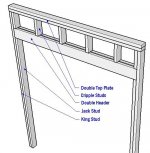Kodi Crescent
Member
- Joined
- Aug 6, 2010
- Messages
- 791
Hi,
I've got myself into a bit of a pickle. I did some floor joist enhancement on my own home where I had to remove and replace some interior non-load bearing walls. I'm in the process of replacing the walls. One wall will be a partition between a closet and a bath. The bath side of the wall will be a tiled shower. The closet side drywall. Another wall will be the partition wall between the bathroom and the living space. The last wall will be the partition wall between the closet and the living space. Both of these partition walls will have doors. The closet will get a 24" hinged door, and the bath to living space partition will receive a pocket door.
I didn't have my wall design and door placement planned out well enough to build the wall on the floor and raise it, so I fastened the top and bottom plate, and then added the studs in between. I used 3" deck screws. I'm working alone, don't have a framing nailer, and I'm not a skilled nailer.
I've been reading various things regarding nails vs. screws. It seems many people prefer nails for a variety of reasons. I asked the PE I had used for my floor stuff about this, and he didn't have any reservations with using the screws. The building code specifies nails though. The walls are up and in place with the screws.
I was considering several options:
1. Do nothing, and leave the screws in place.
2. Toenail in place and keep the screws.
3. Toenail in place and remove the screws.
4. Tear the whole thing down and face nail and toe nail.
Space and help are limited.
Any advice?
Thanks!
I've got myself into a bit of a pickle. I did some floor joist enhancement on my own home where I had to remove and replace some interior non-load bearing walls. I'm in the process of replacing the walls. One wall will be a partition between a closet and a bath. The bath side of the wall will be a tiled shower. The closet side drywall. Another wall will be the partition wall between the bathroom and the living space. The last wall will be the partition wall between the closet and the living space. Both of these partition walls will have doors. The closet will get a 24" hinged door, and the bath to living space partition will receive a pocket door.
I didn't have my wall design and door placement planned out well enough to build the wall on the floor and raise it, so I fastened the top and bottom plate, and then added the studs in between. I used 3" deck screws. I'm working alone, don't have a framing nailer, and I'm not a skilled nailer.
I've been reading various things regarding nails vs. screws. It seems many people prefer nails for a variety of reasons. I asked the PE I had used for my floor stuff about this, and he didn't have any reservations with using the screws. The building code specifies nails though. The walls are up and in place with the screws.
I was considering several options:
1. Do nothing, and leave the screws in place.
2. Toenail in place and keep the screws.
3. Toenail in place and remove the screws.
4. Tear the whole thing down and face nail and toe nail.
Space and help are limited.
Any advice?
Thanks!

